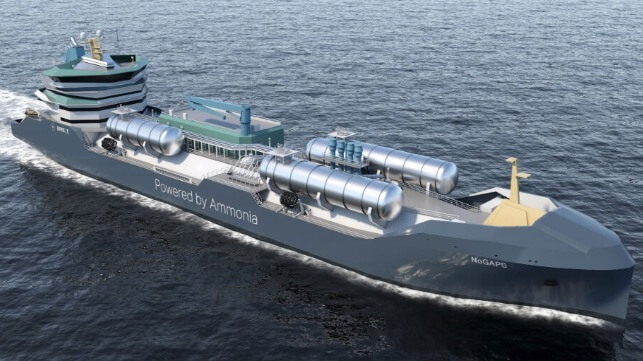Report: Ammonia-Powered Vessels Could be Economical as Early as 2026

Using an ambitious but feasible set of actions, a new report concludes that ammonia-powered vessels will not only be commercially viable but with an aggressive path and broad use of subsidies could be possible as early as 2026. The new analysis from the Global Maritime Forum is the second phase of a project focusing on a first-of-its-kind ammonia-powered gas carrier and reiterates the research’s strong support for ammonia saying they believe the cost gap between operating ships on zero-emission ammonia and conventional fuel could be closed before 2030.
The technology for the use of ammonia as a marine fuel is rapidly advancing with multiple projects reporting strong progress. Research by engine manufacturers including MAN and Wartsila, as well as projects in Japan and with major shipbuilders have achieved the first combustion tests. They are developing fuel supply systems and the approaches for bunkering ammonia are emerging, but the main concern remains the cost of the ships and the operations using ammonia.
The new report concedes, “Without intervention, an ammonia-powered gas carrier is expected to be between 50-130 percent more expensive than an equivalent gas carrier over the coming years. This creates significant commercial risks for both shipowners and lenders.”
As part of the Nordic Green Ammonia Powered Ships (NoGAPS) project, co-funded by Nordic Innovation, the new study from the Global Maritime Forum explores options for addressing those cost concerns. It is the second phase in the project which in 2020 and 2021 developed proof of concept for the prototype ammonia-powered gas carrier and has now been carried out including examining detailed design requirements. The vessel design has gained Approval in Principle from DNV. The new project looked at the pathways for commercializing early ammonia-powered vessels saying that reducing the elevated costs and commercial risks was the primary barrier to finding suitable, competitive financing to introduce the new ships.
“The most effective way to reduce the cost gap between ammonia and conventional fuel is to pull on numerous cost-reduction levers simultaneously,” they write in the report. They identified several methods for responding to the challenges. These include dual-fuel vessel design (i.e., the ability for a vessel to run on conventional fuels as well as ammonia), competitive debt financing arrangements, operational efficiencies, fuel subsidies, and governmental regulation.
“With the completion of this latest project phase, we not only have a detailed ship design that could be used for a shipyard tender but also a feasible commercialization pathways. We hope this boosts confidence amongst charter parties and investors to take steps towards the realization of M/S NoGAPS and other ammonia-powered vessels,” says Jesse Fahnestock, Project Director of the Global Maritime Forum.
A key portion of their model for closing the cost differential however is dependent on subsidies. They point to the opportunities in the US Inflation Reduction Act, which they conclude could reduce operating costs by 20 percent, and the EU’s Fit for 55 Package, which would contribute an additional 10 percent cost reduction. The aggressive model also calls for solely bunkering with US ammonia and optimizing operations.
The report concludes that the cost gap could be closed as early as 2026 and the vessel could also approach cost parity by 2030.
The NoGAPS project brought together leading players from the shipping and energy value chain, including Yara Clean Ammonia, BW Epic Kosan, MAN Energy Solutions, Wärtsilä, DNV, Mærsk Mc-Kinney Møller Center for Zero Carbon Shipping, and the Global Maritime Forum. They were also supported by the Danish Maritime Authority as the flag representative and Breeze Ship Design as the ship designer.
The full report is available online at the Global Maritime Forum site.
No comments:
Post a Comment